Updated: May 23, 2025
Does your utility pricing solution help your organisation respond to market conditions and customer preferences to be more competitive?
At MaxBill, we define a utility pricing solution as software (part of a broader billing or customer information system) that helps utilities to design, manage, and apply tariffs, fees, and discount schemes. It acts as the “engine” behind how utilities calculate what each customer should pay for their consumption.
Nowadays, service-driven, customer-focused businesses (which means competitive businesses), revisit their pricing strategies, going from the basic combo of costs and revenue requirements to the trio: market conditions, customer preferences, and cost.
More income, higher profits, goodwill, robust customer retention, based on product and service options and modern price structures – these are a few of the benefits coming from innovative pricing strategies for energy and utility organisations.
In this article, we will:
- describe the market-oriented approach to pricing and what makes it innovative
- go through individual and business electricity rates and variable energy tariffs
- deliver the kind of information needed to develop strategic pricing for your organisation.
If you’re a forward-thinking utility looking for a competitive utility pricing model, read this.
Key Takeaways
- Cost-based pricing (vs. usage-based pricing) overlooks competitive pressures and customer value, and can lead to higher overall electricity and utility rates.
- At MaxBill, we encourage a market-oriented pricing approach that integrates both cost and value-based pricing strategies.
- Electric utilities typically segment markets by residential, commercial, and industrial, or by demand and voltage levels.
- A more market-oriented approach might be segmented by factors such as climate, housing type, urban versus rural regions, or end uses like HVAC systems, etc.
- Dynamic pricing offers a high level of transparency by reflecting the true costs of energy generation and supply.
- Combining multiple products within a bundle offer can often trigger discounts, incentivising customers to consume more.
- A new-gen AI-driven billing and product catalog from MaxBill is designed to turn complex pricing into catalogs and offers in clicks.
- Agentic AI in billing and product catalog is a brand-new approach to configuring packaging and portfolios.
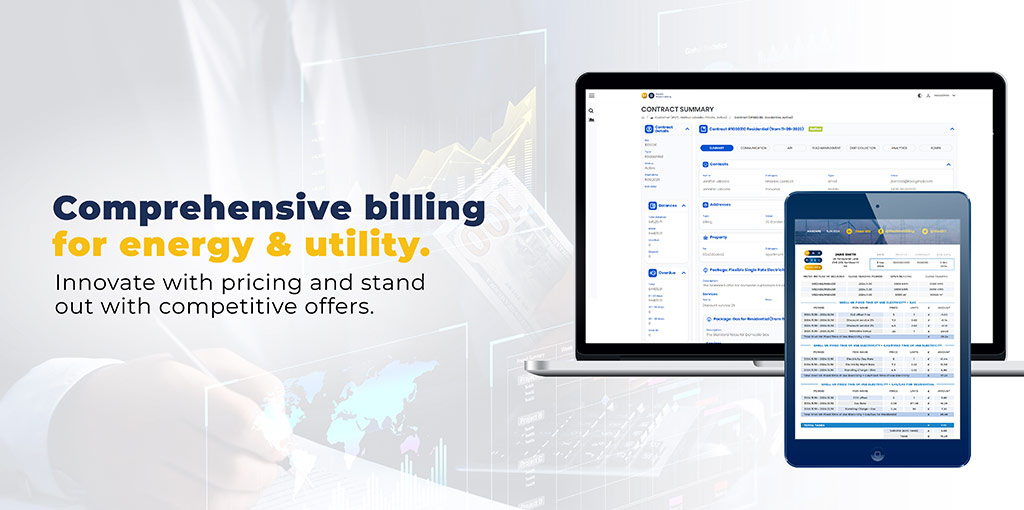
Key aspects of energy price making nowadays

Cost-based pricing (vs. usage-based pricing) is straightforward to calculate, easy to justify to regulators, and often perceived as fair. However, it overlooks competitive pressures, fails to account for variations in customer value, and can lead to higher overall electricity and utility rates.
At MaxBill, we encourage a market-oriented utility pricing model that integrates both cost and value-based pricing strategies, offering numerous benefits to utilities. This strategy enables utilities to:
- Lower average costs by incentivising customers to optimise their energy usage
- Enhance customer satisfaction through a broader range of service options and pricing
- Assess pricing strategies across various scenarios
- Ensure a balance between the cost of service and its perceived value
- Promote economic and energy efficiency by encouraging electricity use when it’s most cost-effective and discouraging it when it’s less.
MaxBill assists with innovative and competitive pricing that encompasses the following components:
- Corporate Goals: If a utility aims to stay competitive, it will likely need flexible pricing, quick pricing responses, and an efficient internal process for pricing decisions, further backed up with modern utility billing solutions.
- Customers: Successful competition involves offering various products and services, diverse business electricity prices and costs for individuals, and different pricing structures tailored to distinct market segments.
Electric utilities typically segment markets by residential, commercial, and industrial customers, or by demand and voltage levels. However, a more market-oriented approach might be segmented by factors such as climate, housing type, urban versus rural regions, or end uses like HVAC systems, lighting, or automation control.
- Costs: With a solid understanding of customer value, it’s possible to restructure prices to enhance customer welfare without raising costs. By incorporating value-of-service into the cost-of-service pricing approach, a utility can design a system that reduces average costs while simultaneously improving customer welfare.
- Competition: To strategically select and price its products and services, a company must understand its current and potential competitors. This includes knowing competitors’ target markets, capacity, costs, prices, and their strengths and weaknesses relative to the utility. To be competitive, it will be crucial to integrate innovative commercial rates into the utility pricing model rather than treating them as exceptions.
- Utility Initiatives: In the United Kingdom, for example, brokers offer price “insurance” to interested customers. This arrangement ensures that the broker compensates the customer if electricity prices exceed a predetermined range, while the customer pays the broker if prices fall below it.
“At MaxBill, by supporting any pricing strategy, we’ll help utilities get more income, higher profits, goodwill, fewer customer service problems, and customer retention.”
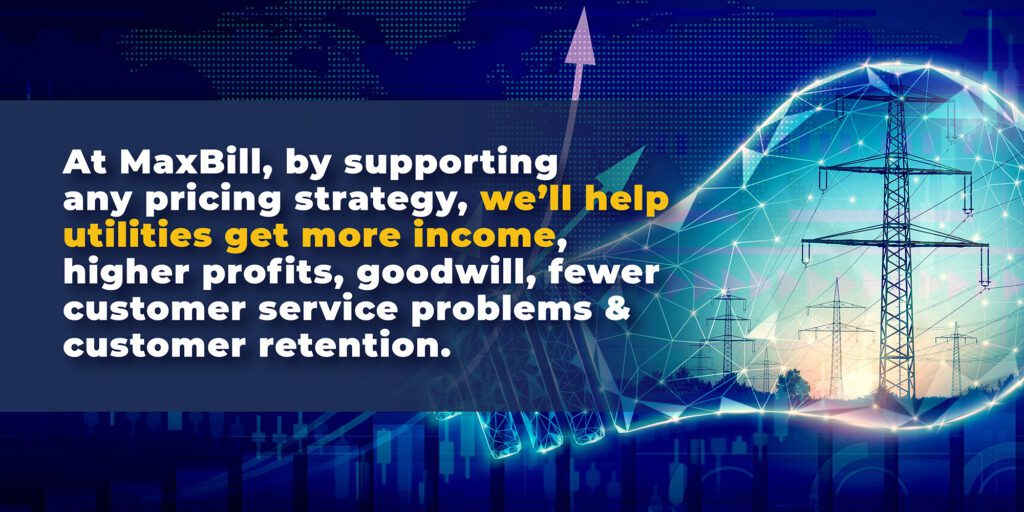
Summary: market-oriented utility pricing model is more beneficial for customers and service providers as it enables flexible pricing, variable pricing offers for customers, cost saving, innovative commercial rates, and even incentives that make offers even more valuable.
Common pricing styles utilities can implement with a utility pricing solution
As a supplier aiming to stand out in the market, your pricing strategies can significantly impact your competitive position. Each utility pricing model has its own advantages and considerations, and the key is aligning these with your customers’ needs and behaviours.
Time-use pricing
Time-use pricing is based on the principle that energy demand varies throughout the day. For example, demand peaks during the day when businesses are open and people are active, and it typically drops at night. Under this model, consumers are charged different rates based on their energy use at different times. Higher rates are applied during peak demand periods, while lower rates are charged during off-peak times.
Dynamic pricing
Time-of-use tariffs are ineffective because they rely on generalised consumption profiles and do not accurately reflect real-time generation costs, leading to imprecise and non-incentivising pricing.
A better alternative is dynamic pricing, flexible consumption-based pricing, which adjusts rates in real-time based on actual supply and demand, providing precise pricing signals that encourage reasonable energy use and support grid stability.
For instance, on a particularly hot day when air conditioning usage spikes, demand increases, and under a dynamic utility pricing model, prices would rise accordingly. Although dynamic pricing introduces an element of volatility that may not suit all consumers, it offers a high level of transparency by reflecting the true costs of energy generation and supply.
Performance-based incentives
Performance-based incentives are a more innovative pricing strategy that aligns closely with energy efficiency and conservation goals. This model rewards consumers for saving behaviours, such as reducing overall energy consumption or using smart appliances. This approach not only helps customers save money but also contributes to the broader goal of energy conservation.
Summary: Pricing models today fell into these key categories: time of use, dynamic, performance-based.
Related:
Dynamic Energy Contracts to Harness Price Volatility and Get Loyal Customers
Half-Hourly Settlement: Is Your Utility Business ‘Reform-Able’?
Types of offers that shape the current utility pricing model
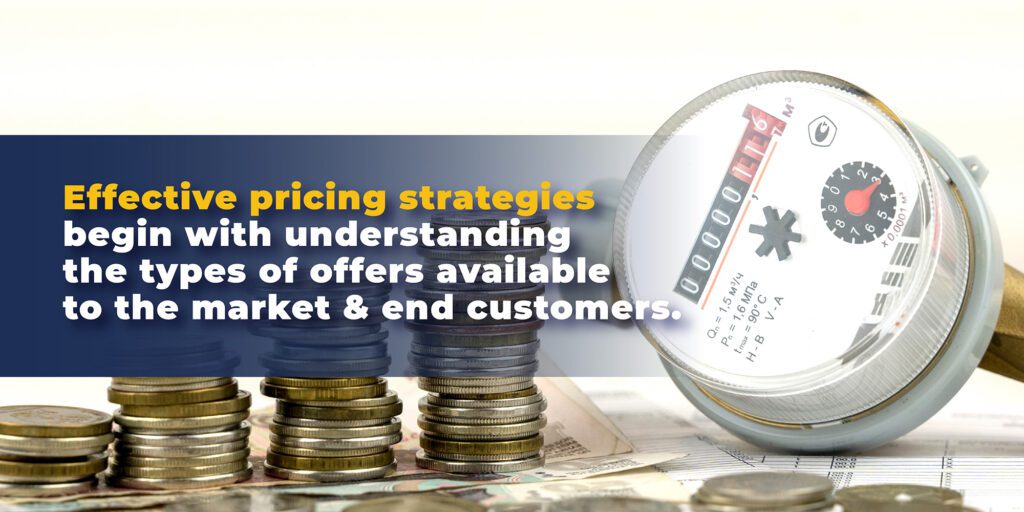
Effective pricing strategies begin with understanding the types of offers available to the market and end customers. We categorize these into two main types: Simple Offers and Bundle Offers.
Simple Offers
A Simple Offer includes any single service or a combination of services related to a single product category, such as electricity, gas, heating and cooling, or EV charging.
Bundled Offers
More complex in nature, Bundle Offers combine multiple products into a single package, which can be billed together on one invoice.
Combining multiple products within a Bundle Offer can often trigger discounts, incentivizing customers to consume more products from the supplier. Typically, the more a customer consumes, the more discounts and multi-policy benefits they receive.
Summary: MaxBill utility pricing solution helps implement any type of offers, incl. most common ones – simple and bundled.
Related:
Types of pricing within these offers for items
At MaxBill, we categorise pricing into two primary types: commodity pricing and non-commodity pricing.
Commodity pricing
Commodity pricing pertains to the direct cost of the specific product being offered. This includes essential services such as electricity, gas, water, heating, cooling, EV charging, and even electricity export. This straightforward utility pricing model focuses on the exact product consumed by the customer.
Non-commodity pricing
Non-commodity pricing involves additional rates and charges that may be applied, particularly relevant for business customers. These customers are required to pay not only for the commodity itself (e.g., electricity or gas) but also for supplementary charges. These additional costs can encompass a range of services or regulatory fees beyond the basic commodity pricing.
Summary: most common types of pricing are commodity and non-commodity, whose different lays down in extra rates and charges coming with non-commodity pricing.
Types of charging in energy pricing making
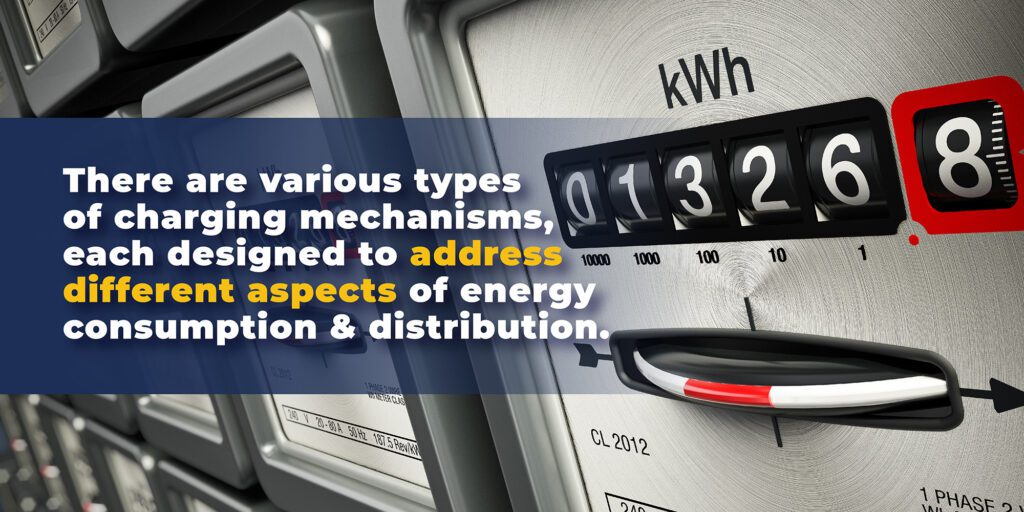
In the energy market, there are various types of charging mechanisms, each designed to address different aspects of energy consumption and distribution. At MaxBill, we recognize the importance of understanding these charging types to provide comprehensive billing solutions.
Pass-through rates
Pass-through rates are typically managed by energy regulators, distribution network operators, or other entities that own these rates. They include:
- Transportation of Energy: Charges related to the transport of energy from generation sites to distribution networks.
- Distribution of Energy: Additional charges for distributing energy to end users.
- Capacity-Based Charges: Charges based on the capacity of the endpoint rather than consumption or subscription. Customers may pay more or less depending on this capacity.
Specific rates that can be configured and applied to a bill include:
- Supply Margin
- Management Fee
- Broker Commission: These are typically defined in contracts with suppliers and applied to customer bills.
These B2B utility pricing charges are common for large-scale customers and may be owned by the supplier or third-party companies providing services like broking.
Summary: pass-through rates are applied by state organisations, not by businesses, while specific ones are up to energy-suppliers and contracts’ specifics.
Commodity price configuration in energy and utility
MaxBill offers flexibility in configuring commodity prices to fit any utility pricing model, which can be applied directly to customer bills. Some configurations include:
- Single Rate (24H Rate): A flat rate regardless of timing or consumption.
- Peak/Off-Peak Rates: Different rates depending on the time of consumption.
- Special Weekend or Holiday Rates: Promotional rates for specific weekends or holidays.
- Band Rates (Staircase Rates): Rates based on consumption bands, where different levels of consumption are charged at different rates.
Discount policies when applying best energy pricing

Each product offer can include various discount policies, such as:
- Discounts for Promotional Periods: Discounts for newly connected customers during the initial billing periods.
- Fixed Discount per Bill: Conditional discounts based on timely payments or accurate meter readings.
- Percentage Discounts on Consumption Charges: Discounts based on exceeding specific consumption thresholds.
Subscription fees variations
Subscriptions can be configured based on different periods, including:
- Daily Standing Charges: Common for gas and electricity.
- Monthly Standing Charges: Management fees typically paid within the billing period.
- Bi-monthly, Quarterly, or Annual Standing Charges: Depending on the billing frequency or regional practices.
Brand new MaxBill AI billing and product catalog: utility pricing models and energy pricing B2B
A new-gen AI-driven billing and product catalog from MaxBill is designed to turn complex pricing into catalogs and offers in clicks. An AI-agent quickly catches what’s needed and designs pricing structures in seconds. It’s a brand new approach to configuring packaging and portfolios.
It’s ideal for energy pricing B2B structures with different commercial offers and intricate financial settlements. The good news is that no implementation project is required. You get it and go execute on delivering quickly configured offers to customers.

Energy export and energy purchase
As energy export becomes increasingly popular, managing the export to the grid alongside comprehensive billing has become a critical topic. Understanding how to credit a customer’s bill for the value of the electricity they send to the grid is essential. When a customer exports it, such as from solar panels, this amount is credited against their invoice, reducing their overall cost.
Solar panels convert sunlight into electricity, which is then used in the home. Any excess one flows into the electrical grid, and the utility’s meter measures both the electricity used from and sent to the grid. The utility credits the customer’s bill for the value of the exported one.
To support this process, it is possible to configure electricity export commercial tariffs in addition to standard pricing. These tariffs are applied specifically to exported consumption and can include features such as banding and peak/off-peak pricing. These features can be integrated into the regular customer bill, effectively reducing the overall cost for the customer.
Summary: if your utility offers customers’ energy export to the grid, your standard pricing scheme evolves and you can create even more value for both, also by leveraging the powrful utility priving solution as part of modern billng.
Forecast capabilities for energy purchasing companies
MaxBill comes with three extra offers to meet the needs of advanced business models:
- Advanced billing models that deliver revenue forecasts based on price forecasts and demand forecasts.
- Support for energy companies by predicting how changes in the market will affect portfolios in the future.
- Using “What-if simulation” to identify which scenario will work the best for the organisation.
A glimpse into forecast activities for energy purchasing

Tools for trading managers
Specific tools are provided to aid trading managers in making informed decisions about energy purchases. By leveraging advanced forecasting capabilities tied to specific service points or customer segments, MaxBill delivers quotations based on demand forecasts, aiding trading managers in making better purchasing decisions.
Consumption forecasting
MaxBill offers energy consumption forecasts based on industry best practices, algorithms, and AI models to estimate future electricity consumption. Utilising AI models and algorithms, MaxBill accurately forecasts kilowatt/hour consumption, providing detailed billing information based on these predictions.
Advanced billing and cost structure analysis
Based on comprehensive cost structures and commercial offers that clients communicate to MaxBill, we can bill in advance, providing a clear financial overview that includes potential earnings, costs, taxes, and payments to generators and distributors and other participants.
What-if scenario simulations
MaxBill provides analytical tools for simulating various scenarios, such as significant changes in generator oil prices, and their impact on energy portfolios. Using demand forecast capabilities, including AI-based and algorithmic models, MaxBill’s tools enable companies to simulate and analyse different scenarios, aiding in strategic decision-making for large-scale energy purchases.
Summary: MaxBill equips trading managers with AI-driven forecasting, scenario simulations, and cost structure analysis to optimise energy purchasing decisions. By combining consumption predictions with financial modelling, it enables accurate quotations, proactive billing, and strategic planning for market changes.
Summing up: the key focus of an innovative utility pricing solution
Customer-centric utilities should focus on creating energy products, services, and utility pricing models that align with customer demands while strategically leveraging their physical and human resources to remain competitive in the evolving industry landscape.
An intelligently executed strategic pricing policy can enhance value for both customers and service providers. Setting up and supporting any time of innovative pricing policy becomes critical here.
Contact our pros to get aid in implementing any pricing strategy, accurate billing and invoicing.

Watch the webinar “Innovative Pricing Strategies for Energy and Utility”
Utility pricing model FAQ
What is a MaxBill utility pricing model?
At MaxBill, utility pricing model by MaxBill embraces a market-oriented pricing design approach that integrates both cost and value-based pricing strategies.
What are the 3 pricing models?
The top 3 utility pricing models are based on time-use pricing, dynamic pricing, and performance-based incentives.
What is an example of a usage-based pricing model?
Usage-based pricing is based on the real-life electricity consumption of customers. Utilities should offer this kind of pricing to satisfy customers with their real-life energy bills.
